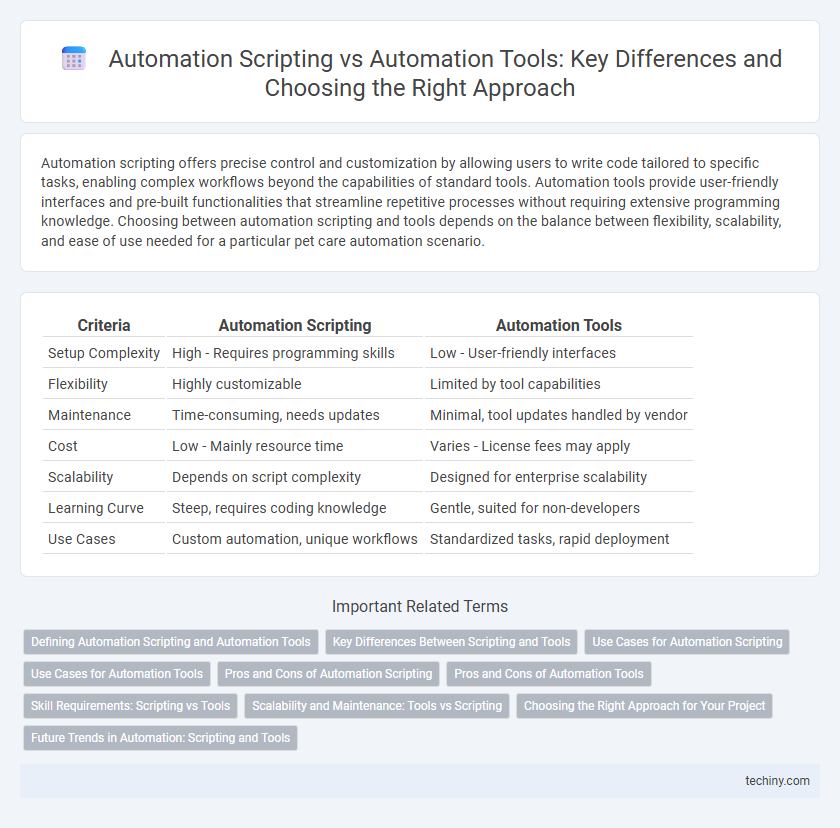Automation scripting offers precise control and customization by allowing users to write code tailored to specific tasks, enabling complex workflows beyond the capabilities of standard tools. Automation tools provide user-friendly interfaces and pre-built functionalities that streamline repetitive processes without requiring extensive programming knowledge. Choosing between automation scripting and tools depends on the balance between flexibility, scalability, and ease of use needed for a particular pet care automation scenario.
Table of Comparison
| Criteria | Automation Scripting | Automation Tools |
|---|---|---|
| Setup Complexity | High - Requires programming skills | Low - User-friendly interfaces |
| Flexibility | Highly customizable | Limited by tool capabilities |
| Maintenance | Time-consuming, needs updates | Minimal, tool updates handled by vendor |
| Cost | Low - Mainly resource time | Varies - License fees may apply |
| Scalability | Depends on script complexity | Designed for enterprise scalability |
| Learning Curve | Steep, requires coding knowledge | Gentle, suited for non-developers |
| Use Cases | Custom automation, unique workflows | Standardized tasks, rapid deployment |
Defining Automation Scripting and Automation Tools
Automation scripting involves writing custom code to automate specific repetitive tasks, allowing precise control and flexibility tailored to unique workflows. Automation tools are pre-built software solutions designed to simplify automation processes through user-friendly interfaces and standardized functions, reducing the need for extensive programming knowledge. Both approaches enhance efficiency, but automation scripting typically requires programming skills, whereas automation tools cater to users seeking streamlined, ready-to-use automation capabilities.
Key Differences Between Scripting and Tools
Automation scripting involves writing custom code to perform specific tasks, offering high flexibility and control but requiring programming expertise. Automation tools provide pre-built interfaces and workflows that simplify task automation without deep coding knowledge, enhancing usability and speed of deployment. Key differences include customization level, ease of use, and scalability, with scripting suited for complex, tailored solutions and tools ideal for standardized, repeatable processes.
Use Cases for Automation Scripting
Automation scripting excels in custom workflows and complex task automation where tailored solutions are required, such as batch processing, data transformation, and integration of disparate systems. It allows developers to write precise scripts for repetitive tasks, enabling fine-grained control over the automation process. Use cases include automating system administration, continuous integration pipelines, and custom application testing beyond the capabilities of generic automation tools.
Use Cases for Automation Tools
Automation tools excel in scenarios requiring complex, repetitive tasks across multiple systems, such as continuous integration/continuous deployment (CI/CD) pipelines and automated testing frameworks. They offer user-friendly interfaces and pre-built modules that simplify deployment, configuration management, and workflow orchestration in enterprise environments. Automation tools also provide enhanced scalability, error handling, and reporting capabilities compared to scripting, making them ideal for large-scale infrastructure management and multi-team collaboration.
Pros and Cons of Automation Scripting
Automation scripting offers high flexibility, allowing customization tailored to specific workflows and environments, which can significantly improve efficiency and control. However, it demands advanced programming skills and considerable time investment for development and maintenance, posing challenges for teams without dedicated technical expertise. Scripts may also lack the robustness and user-friendly interfaces found in commercial automation tools, potentially limiting scalability and ease of use.
Pros and Cons of Automation Tools
Automation tools offer user-friendly interfaces and pre-built functionalities that accelerate deployment and reduce the need for advanced coding skills. They enhance collaboration through centralized management and real-time monitoring but can be limited by higher costs and less flexibility compared to custom scripting. Scalability and integration capabilities vary widely among tools, making the choice dependent on specific project requirements and existing IT infrastructure.
Skill Requirements: Scripting vs Tools
Automation scripting demands strong programming skills and in-depth knowledge of coding languages such as Python, JavaScript, or Bash to create custom workflows and solve complex problems. In contrast, automation tools typically require less coding expertise, focusing on configuring pre-built modules through user-friendly interfaces, which appeals to users with limited programming background. Understanding the skill requirements helps organizations match the right resources to automation projects, enhancing efficiency and scalability.
Scalability and Maintenance: Tools vs Scripting
Automation tools offer enhanced scalability by providing pre-built frameworks and user-friendly interfaces that simplify the extension of workflows across large environments. Scripting enables granular control but often leads to increased maintenance complexity as scripts grow and require constant updates to adapt to system changes. Choosing tools over scripting generally reduces long-term maintenance efforts and supports seamless scaling in dynamic automation deployments.
Choosing the Right Approach for Your Project
Automation scripting provides customizable, code-based solutions ideal for complex, unique workflows requiring precise control, while automation tools offer user-friendly interfaces and pre-built functionalities designed to accelerate deployment in standard processes. Project complexity, team expertise, scalability requirements, and integration capabilities are critical factors when choosing between scripting and tools. Organizations benefit from evaluating specific use cases, maintenance overhead, and long-term flexibility to select the most effective automation approach.
Future Trends in Automation: Scripting and Tools
Automation scripting enables customized, precise workflows by allowing developers to write code tailored to specific tasks, fostering flexibility and innovation in process automation. Automation tools, equipped with AI-powered features and low-code interfaces, are rapidly evolving to democratize automation, making it accessible to non-technical users and accelerating deployment times. Future trends highlight a convergence where scripting integrates seamlessly with intelligent automation platforms, powered by machine learning and natural language processing, optimizing efficiency and adaptability in dynamic business environments.
Automation Scripting vs Automation Tools Infographic

 techiny.com
techiny.com